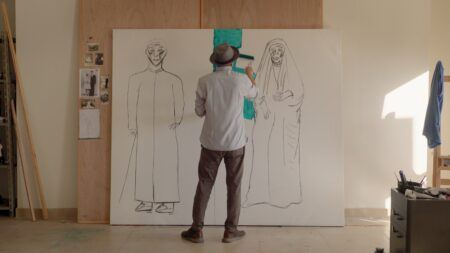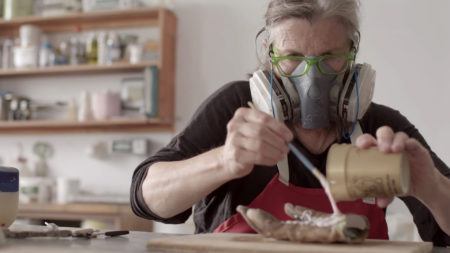Interview
“CREMASTER 3” (Saratoga Race Course)

On the set of CREMASTER 3 (2002), Saratoga Race Course, Saratoga Springs, NY, 2000. Production still from the Art in the Twenty-First Century Season 1 episode, Consumption, 2001. © Art21, Inc. 2001.
Artist Matthew Barney discusses filming CREMASTER 3 at the Saratoga Race Course in Saratoga Springs, NY.
ART21: What role does this scene at the Saratoga racetrack play in the overall story of CREMASTER 3?
BARNEY: This is actually a really brief cut away from the story that takes place in the Chrysler tower. The scene it cuts away from describes a character who has betrayed a labor union that he has a relationship to. In the scene at Saratoga Springs, he’s seen watching a harness race and, as the horses come near, he sees that the horses are running and are dead—it’s a bit of a forecast as to what will become of him. It continues a type of scene that the film starts with, where a character is shown digging herself out of her grave. It’s shot and lit like a classic zombie film, and in a certain way, this is a continuation of that. So, the film will start in one way aesthetically, and then switch gears about six minutes into it. It’ll start within the horror genre and then immediately move out of it into a kind of Art Deco, gangster genre.
ART21: How did you work with Gabe Bartolos to realize the horror genre special effects with the horses?
BARNEY: Well, in a certain way this was easy. It was a very difficult thing for him to pull off, but in terms of communication between the two of us, this one was easy, in that we were dealing with an understood anatomy. We’re talking about a dead horse, and the questions were really just about how long has the horse been dead and what environment was it decaying in—kinds of questions that he’s used to asking. So, my preferences were with a more moist zombie rather than a dry one, which would mean a moist environment and a shorter amount of time that it had been there. So, Gabe went to a place that’s an animal removal center; there are ranches that are large enough to have livestock that would be dead in the field, and an animal could go for weeks, lying there before it was found. This agency goes and removes that animal and removes the bacteria-filled earth beneath it. He was able to photograph a lot of different animals at different stages of decay; it was an easy way to look through the video and look through the still photographs and say, “You know, this looks like the carcasses in the meat packing district, and this doesn’t—this looks rotten.” We also looked at some pathology books and examples of human cadavers that were telling us the same kind of thing that we were interested in—a level of decay that started to bring green into the red. I don’t know if you can see this, but this was a really good example of the type of color that I wanted to work with—where you have a memory of red, but it’s being replaced by green and gray. There’s a level of moisture that Gabe was able to achieve up at Saratoga with a lot of the gels that he uses.

Make-up artist Gabe Bartalos on the set of CREMASTER 3 (2002), Saratoga Race Course, Saratoga Springs, NY, 2000. Production still from the Art in the Twenty-First Century Season 1 episode, Consumption, 2001. © Art21, Inc. 2001.
ART21: How did you prepare to work with the horses, especially since they’re wearing such elaborate costumes?
BARNEY: The person who really ran the shoot in Saratoga was the vet. He was the person who told us when we had to stop and when we could continue shooting again. And that sort of happens if we get into an effect or an area that’s a little esoteric; somebody tends to come forward to sort of run the show, a specialist. That certainly happened in Saratoga because these were full-body suits that the horses were wearing, and they were absorbent. They were filling up with sweat and the horses were becoming fatigued and overheated. So, we would do two takes and the vet would say, “That’s it. They need to rest. The suits need to come off,” and that’s what we would do. The same thing happened with the bulls in CREMASTER 2. It was basically a single camera shoot, but we needed to have multiple angles of a bull bucking. So, we did our best to find two bulls that were identical, so that we could work in the morning and work in the evening on two different bulls, two different riders. Bulls are just not used to bucking twice in one day. They’ll buck once, that’s it. And so, we were able to push the rider and the animal as much as we could, by shooting once a day over the course of four days. We’d do a shot like this, and we’d get two production blocks out of having twin riders and twin bulls. A vet kind of ran that shoot, too, and all the animal handlers as well, because animals, as anybody knows, are difficult to work with. A little bit unpredictable, but the challenge is nice.
ART21: Could you explain the significance of this film in the CREMASTER series?
BARNEY: Well, this is central. It’s number three in a series of five stories that, in a certain way, meet in the middle. It’s a cycle, in a sense, but the central theme is shaping up to be a bit of a mirror—a two-sided mirror that’s sending the entire cycle into two elliptical paths. So, in that sense, there’s a character—the Chrysler building—which is reflected by its architect, whose character is functioning in the same way. I don’t want to get too esoteric on you here, but it’s sort of in the fashion of Ayn Rand’s book, The Fountainhead. The architect is guilty of hubris. He’s feeling that he can look out over the two halves of the story (Chapters One and Two, then Four and Five) and resolve them.

On the set of CREMASTER 3 (2002), Saratoga Race Course, Saratoga Springs, NY, 2000. Production still from the Art in the Twenty-First Century Season 1 episode, Consumption, 2001. © Art21, Inc. 2001.
ART21: How do the horses relate to this tension?
BARNEY: Well, the horses are meant to foreshadow the fate of this betrayer. What he sees is a field of ten horses in harnesses, running dead. It’s the same way that this zombie character in the beginning is a sort of resurrection of the executed Gary Gilmore character from CREMASTER 2.
ART21: Is it a dream or is he seeing a strange reality?
BARNEY: Well, I don’t really look at these films in the way that I sort of need to, to answer that question. I mean, they’re not any more real than the character is.
ART21: Numbers seem to be very significant throughout the CREMASTER series. Why ten horses?
BARNEY: There are five teams of two horses and the five teams correspond to the five CREMASTER episodes. This happens a couple of times in CREMASTER 3, but the five projects are represented either quite literally, in the way that they are here, or symbolically, through species of flowers. That happens a couple of times, where CREMASTER 1 is represented by the orchid; 2, the glacier lily; 3, the narcissus; 4, the Irish gorse; and 5, the calla lily. The silks of the riders carry the coat of arms of each of the CREMASTER pieces, and this race tells a particular story. The riders from CREMASTER 5 have cut off the horses from CREMASTER 1, are guilty of a foul, and are therefore disqualified. So, CREMASTER 1 bumps up into second place, and there’s a photo finish (a dead heat) between the two horses from CREMASTER 3. It’s a little story that takes place during the scene.

Matthew Barney on the set of CREMASTER 3 (2002), Saratoga Race Course, Saratoga Springs, NY, 2000. Production still from the Art in the Twenty-First Century Season 1 episode, Consumption, 2001. © Art21, Inc. 2001.
ART21: Why is CREMASTER the title of these films?
BARNEY: The cremaster is a muscle that controls the height of the internal reproductive system in the male. I took that as a title for a couple reasons, primarily in that the story, over the course of five chapters, has to do with a kind of system whose state is fluctuating, not necessarily literally as a reproductive system, but as a system whose identity is changing. CREMASTER has been taken on here as a kind of stand-in for conflict. The five chapters of the story are about an organism that is changing, and the system that changes that form alters from chapter to chapter. In certain cases it’s autonomic, meaning that the cremaster muscle is part of the architecture of the story and it doesn’t really have an agency or character. In other cases, there are characters, defined characters, that are in conflict with one another over the state of that form. So, it is being used in a lot of different ways as an idea. It’s essentially about an imposed will onto the state of the form, sometimes in a very abstract way, sometimes in a more literal, biological way. But it’s basically a structural word. It’s being used as a way to tell the story and not as a way to define a biological system at all.
This interview was originally published on PBS.org in September 2003 and was republished on Art21.org in November 2011.



